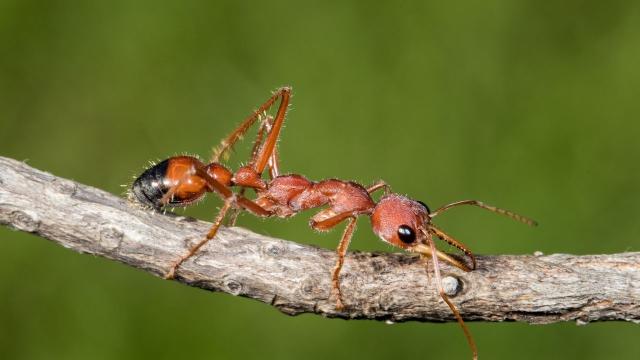Y’all ready to talk about ants?
A molecule found in Australian bull ant venom intended to ward off predators could be perfect for helping people with long-term pain, at least according to researchers from the University of Queensland.
“Venoms are complex cocktails,” says Doctor Sam Robinson from the University of Queensland Institute for Molecular Bioscience (please note, Gizmodo Australia doesn’t recommend putting ant venom into an actual cocktail).
“While bull ant venom contains molecules similar to those found in honey bee stings which cause immediate pain, we also found an intriguing new molecule that was different.”
This molecule, in particular, was found to match those found in mammalian hormones. Of closest comparison, oddly enough, was the humble echidna. In the echidna, a similar molecule was found in Epidermal Growth Factor (EGF) hormones.
“Many small carnivorous marsupials, like bandicoots, eat individual ants, but only the echidna is known to attack bull ant nests and target their young – we think that making the echidna sensitive to pain, in tandem with the immediate ‘bee-sting’ pain, may dissuade it from returning to the nests,” continued Robinson.
“You can see clearly in the ant’s DNA that it is producing a molecule that mimics a hormone of its natural enemy and is using it as a weapon against it – it brings to mind the ancient proverb ‘to know your enemy, you must become your enemy’.
“We went on to show that while it didn’t cause direct pain, the molecule did cause long-lasting hypersensitivity.”
So the echidna, an animal that loves to snack on the odd bull ant nest, has a similar molecule found in its DNA to that which is found in the ant itself. What’s more, is that the molecule found inside of the ant could help us in treating long-term pain, as it’s a defence mechanism specifically against the spikey insect lover.
It’s a pretty cool thing to see in nature. To dissuade echidnas from returning to ant nests, ants leave an unfortunate pain in mammals eating their nest.
The team behind this research believes that further study could inspire new ways to treat things like tumour growth. EGF-inhibitor drugs already exist on the market, but further research on this molecule could bring new treatments to light.
“We hope that by highlighting the role of this signalling pathway in pain, we can encourage different strategies for pain treatment, especially long-term pain for which treatment is currently limited,” Robinson added.
These findings were published in the Proceedings of the National Academy of Sciences of the United States of America (PNAS).
